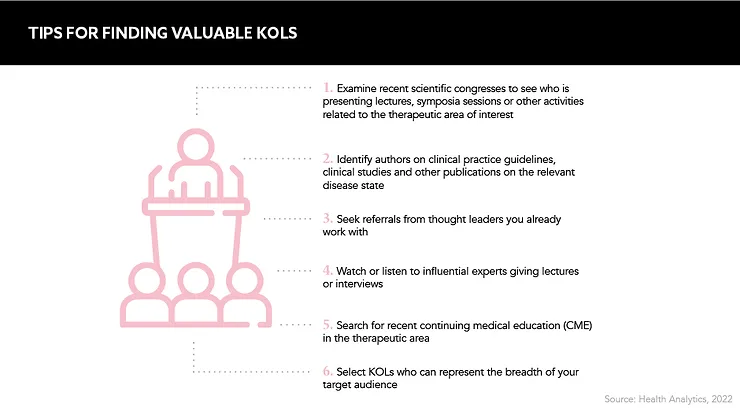As masters of science and influence, key opinion leaders hold great value for pharmaceutical companies. While partnerships have existed for many years, questions remain as to how this relationship could be upgraded and optimised in light of digital transformation
Words by Jade WIlliams
Key opinion leaders truly have the power to tip the scales when it comes to pharmaceutical marketing. These highly respected life sciences and medical experts can twist and change opinions at the drop of a hat, encouraging – or even discouraging – healthcare professionals to trial a new product or therapy.
According to Mark Benthin, Founder and CEO, Viihealth, the time is ripe to improve the impact a KOL can have. “There’s a huge increase in the demand for digital-based content and authentic, original content where you can hear material from the horse’s mouth,” he states, speaking at NEXT Pharma Summit’s NEXT Normal event in December 2022. Partly born from necessity during the COVID-19 pandemic, digital content has become the new norm for HCPs due to its increased accessibility and potential to be much more engaging than some traditional outputs. People are going to the internet and other digital platforms as a first port of call and are expecting a high level of quality content. Pharma must supply this.
As such, Benthin notes that KOLs will likely “be a digital opinion leader (DOL) at some point as well”. Indeed, the divisions between the digital and physical worlds have continued to erode over the past few years, and, as such, KOLs must be adequately prepared to effectively use the social media space. “It may take them a little bit more time to get there, but there’s no reason why somebody who is that successful offline will not also be successful online,” Benthin adds.
The omnichannel effect
Taking this one step further in her own contributions at NEXT Normal, Souhila Ahdjoudj, Senior Director, Worldwide Field Medical Excellence, Immunology and Fibrosis, Bristol Myers Squibb, says that despite the rising number of DOLs, the adoption of omnichannel means that, ultimately, digital or otherwise, “an opinion leader is an opinion leader”. What matters, she adds, is the “skills and sphere of influence an individual can bring and how it matches with the pharmaceutical company’s objectives”. This should be understood, tailored and leveraged on a case-by-case basis.
There is no reason why somebody who is that successful offline will not also be successful online
In addition, the potential of omnichannel is multifaceted as it creates an opportunity for a streamlined relationship between KOLs and pharma marketing teams. “We’re always looking to avoid bombarding these KOLs by asking for tons of information or duplicating points of contact,” says Ahdjoudj. “This is where omnichannel may bring a lot of opportunities to simplify the approach, making sure it matches the expectation [KOLs] have in terms of communication and partnership.”
Ahdjoudj urges marketing teams to understand and tailor the chosen content channel for each KOL, utilising different individuals based on parameters such as “their specialty, where they are working, their countries, the generation they belong to and whether they are savvy in terms of the digital space. Everything will be related to [achieving] the right balance to tailor the customer experience and to address their needs”. As such, leveraging relationships with multiple KOLs is vital, and selecting a KOL with a certain specialism and network to reach a niche group, even if they have a smaller following, is advisable alongside connecting with those with large and loyal audience bases.
What the customer wants
It goes without saying that aligning a product or therapy with a trusted and valued face, along with an engaging blog post, video, podcast or other content type, can deliver a wave of influence over potential customers. If an HCP is interested in engaging with such content, it also “has to be readily accessible across any of the various channels [an HCP] would like to view”, explains Benthin. “If it’s a great topic with great speakers, presented in a way that they can consume it easily, then that demand will certainly be there.”
Quality is highly important, especially when it comes to compliance, but quantity is arguably just as crucial as people resonate with varied media types. Pharma must therefore strive to cater for all preferences to ensure everyone can find content they can easily understand and digest. One or two articles may not be enough to persuade an HCP to consider a new therapy. Therefore, building a weighty bank of KOL content is key to tackling this challenge head on.
Pharma must treat KOLs as collaborators, not just mere marketing tools
For Benthin, this sufficient volume of diverse and readily available content should also be rateable. “The receiving physician should be able to judge with their mouse clicks or their thumb taps as to what content they find to be valuable in a particular topic area,” he states. A formal rating system may leave companies open to poor reviews, but it could also help to ensure KOLs are delivering the most useful content to HCPs. Analysing engagement figures could also bolster these insights, indicating which KOLs are resonating with audiences and whether one KOL should be used more frequently over another.
Keep it simple
Benthin and Ahdjoudj agree that pharma’s approach to harnessing KOLs could be more personalised, but also that the industry should be careful to avoid over complication. “We often over engineer everything we do because pharmaceutical companies are science based, and that’s something important to consider,” says Ahdjoudj. “We need to digest the information to give KOLs the right materials and the right content.”
Summarising this strategy’s potential, Bethin adds: “There are many things from a capability perspective which – if they’re done in a straight forward manner with today’s technology – could enable a KOL to become a star overnight,” he says. “We need to focus on making it easy, so optimising their time and the distribution that they can achieve. Those are the ways that a new era of technology can help KOLs become DOLs so that everyone is just an OL.”
Ultimately, the pharma-KOL relationship must not be transactional. A KOL’s influence helps raise awareness for bringing new and improved medicines to market, but to build strong and long-lasting connections, pharma must treat them as collaborators, not just mere marketing tools.
With such a vast period of transformation currently playing out, pharma companies must work quickly and smartly to leverage the huge marketing successes that KOLs can bring to the table.










